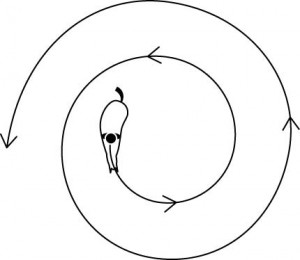Q: I am riding a lesson horse who is hot but also has a tough mouth. I am a quiet rider so I know how to handle hot horses, but I am wondering if there are any horse training exercises to help me slow the horse down and do downward transitions?
KRISTIN SCHMOLZE
A: Nine times out of 10, horses like this have not been educated to their riders’ legs. Because their only response to leg pressure is to go faster, their riders find it intimidating to put leg on. But this is exactly what an excitable horse needs. Teaching him to bend his body in response to leg pressure shows him that leg can mean more than one thing. Once he understands this, he will begin to accept leg contact. This has a wonderfully calming effect on a horse and instills confidence in both horse and rider. It also encourages the horse to concentrate more on your legs than your hands, thus producing a softer, more responsive mouth.
 The spiral exercise teaches your horse to yield laterally to leg pressure and bend, which in turn will make him easier to control.
The spiral exercise teaches your horse to yield laterally to leg pressure and bend, which in turn will make him easier to control.I use a two-step process to educate horses to the leg. You can teach it to this school horse as you walk around the arena in the minutes before your lessons start. It may take five to 10 lessons to see significant results, but even if his other riders aren’t reinforcing these new skills, he will improve each time you ride him.
Exercise 1: Start by asking the horse to yield laterally to leg pressure. Walk on a 15- to 20-meter circle, sitting in the middle of the saddle and stretching your upper body tall. Establish a light contact, always communicating with the horse but never hanging or pulling back on the reins. Then step into your inside stirrup, dropping weight into that heel and feeling your whole leg in contact with the saddle and horse.
Next, make an opening rein with your inside hand by bringing it several inches to the inside. At the same time, lighten your contact in the outside rein slightly. With your inside leg at the girth and your outside leg slightly behind the girth, engage the calf muscle of your inside leg and increase the pressure of your entire leg against the horse. Hold that pressure for a few seconds and then release it. Repeat this several times until he responds by moving sideways away from your leg, increasing the size of the circle slightly. Reward him with your voice or a gentle scratch on the neck with your inside hand and then ride forward on the circle again.
Progress slowly with this exercise. At first, ask for only a small increase in the size of the circle, encouraging gradual, smooth lateral movement. If he moves abruptly and quickly sideways, losing his forward momentum, you’ve asked for too much. After several repetitions, do the same exercise in the other direction.
If your horse doesn’t move at all sideways in response to your leg initially, check to make sure that you’re not confusing him by collapsing your upper body to one side or the other. Then try reinforcing your leg aid with a dressage whip. Carry it in your inside hand and tap it lightly behind your leg at the same time that you apply the lateral aid.
Exercise 2: When your mount seems to understand this concept of moving away from your leg, you can begin to ask him to bend through his body. Walk on a 15- to 20-meter circle again, and apply the same opening rein and inside leg pressure. This time, add a few more ounces to the contact on your outside rein to tell him that you don’t want him to move sideways. As you continue to squeeze and release the inside leg, you should feel the horse begin to bend his body around your leg and soften in your hands. Reward this positive response by softening the contact and praising him verbally or giving him a scratch on his neck, and then walk forward on the circle again.
Again, do this exercise in both directions. As he tunes in to your legs more and becomes more supple in response to them–rather than just going faster every time you put them on–you can start doing these exercises in other gaits, as well.
Once the horse seems to understand the bending aids, apply them during downward transitions. Even on a straightaway, ask for a slight inside bend when you cue him to slow down. Continue asking for the bend until he reaches the desired pace. This will make him suppler in his body and lighter in your hands–and much easier to control.
Kristin Schmolze was named the US Eventing Association’s Young Rider of the Year in 2003, a year in which she was the top-placing Young Rider at two CCI*** events and won individual silver and team gold medals at the North American Young Rider Championships. In 2005, she placed 12th in her first CCI****, the Rolex Kentucky Three Day Event. Now based at her family’s Everbreeze Farm in Califon, New Jersey, Kristin partners with Ireland’s Kedrah House Stud, importing young Irish Sport Horses to compete and sell in the United States. This year, she and Ballylaffin Bracken were selected as alternates for the US Pan American Games eventing team.
This article originally appeared in the February 2012 issue of Practical Horseman.










